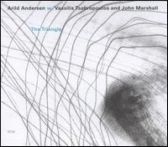
|
||||||||||||||||||||||||||||||||||||||||
| Arild Andersen w/ Vassilis Tsabropoulos and John Marshall - The Triangle (2003) |
| Front Cover | Album Info | |||||||||||||||||||||||||||||||||||||||||

|
|
|||||||||||||||||||||||||||||||||||||||||
| Musicians | Credits | ||||||||||||
|
|
| Track list | |||||||||||||||||||||||||||||||||||||
|
| Notes |
| AMG Review by Thom Jurek (4): Perhaps the most startling aspect of the Triangle, Arild Andersen's 15th date as a leader, and his second with pianist Vassilis Tsabropoulos and drummer John Marshall is their re-visioning of the trio. Though Tsabropoulos composed five of the nine pieces here, he does not compose for himself as the centerpiece of the trio's expression. The bass is the true centerpiece of this group's language. And it is not simply because Andersen is the group's "leader." Tsabropoulos was a classical player who came to improvisation late, and jazz later. His phrasing is unique and rhythmic, and his writing lends itself to notions of pulse and color rather than single-line flights of inquiry. Andersen's long-handed style offers unique articulation of the rhythmic pulse allowing for his part to balance Marshall's dancing style of drumming with the knottier eloquence of the Tsabropoulos five- or six- note motifs. The beautiful "Choral," is one example where Andersen's undersided melodic notions are colored by the beautiful chromatic voicings of the pianist. Marshall skitters and shimmers with his brushes, playing through them the rhythm. "Andersen's Saturday," is signatory in that it offers a wonderfully direct flow of even-handed grooves and layers of melody that present themselves in the foreground and reveal their full meaning in the rhythmic push and pull. "Pavane" offers another side of the Triangle with its crystalline lyric and parsed out rhythm coming from shards of chordal investigation. The closer, "Cinderella Song" by Tsabropoulos, strolls unhurriedly though shapes and rounds with Andersen's phrasing being the piece's "singing voice." The Triangle is a refreshing and sophisticated new way to hear the trio. |